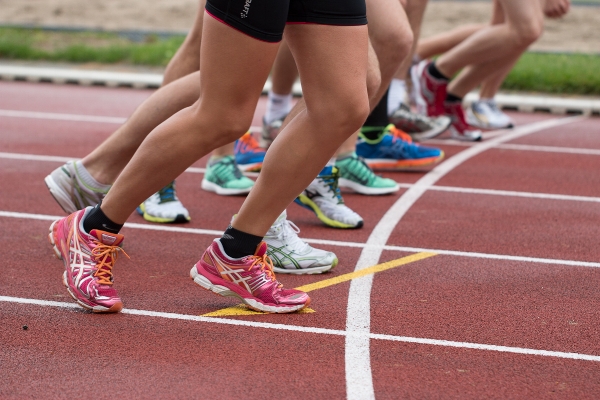I have been a long distance runner for about 16 years now and as I get order I am experiencing less aches and pains than I did in my younger years, which is contrary to what many may expect. Therefore, I wanted to investigate if long term distance running could actually increase the rate of arthritis development at the knee joint.
This article will shed some light on what research says on the matter and I hope you feel delightfully surprised.
What is Arthritis?
Arthritis is the inflammation of a joint, and there are actually many types of arthritis. The most common form is osteoarthritis.
Osteoarthritis (OA) is the degeneration of bone surfaces, in other words “wear and tear” of a joint. Usually the cartilage will wear away first, which means there will now be exposure of bone surfaces (decreased joint space). When the bones are exposed there will be bone on bone rubbing which leads to pain, grinding , swelling, buckling, and stiffness.
What causes Osteoarthritis?
There are many factors are contribute to the wear and tear of the joint. One of them is your age. I tell my clients to remember that all of our tissues expire, we just have a long expiration date.
· Individuals over the age of 50 tend to have or develop arthritis. Makes sense, 50 years of loading a joint will eventually cause some wearing out.
· Being overweight increases the chance of developing OA. More load causes more stress, and eventually more wear and tear compared to someone who is not overweight.
· History of knee injury- such as ACL tears, severe meniscus injuries, meniscectomies (removal of meniscus) because the integrity of the knee was been altered , causing more instability and thus more stress and rubbing.
· Strenuous repetitive activities - now this list varies from article to article. Some list long distance running as a strenuous activity other do not. (2,4)
What does research say about running and knee osteoarthritis?
As a researched I found articles dating back to 1986 researchers have no found a strong link between lifelong distance running and early development of OA. A study in 2008 looked at 45 long distances runners and 53 controls (non runners). The runners were the average age of 58 when the study started in 1984 and were followed through 2002. The goal of the study was to document difference in knee osteoarthritis over the course of the years in runners and non runners. Towards the end of the study the researchers took and analyzed radiographs in both groups and found that the runners did NOT demonstrate more OA development than the non- running group (3).
A recent 2017 research report was published by the Journal of Orthopaedic and Sports Physical therapy that looked at the very question. The purpose of this article was to do a meta- analysis of articles evaluate whether there is an association between knee and hip OA with running. They analyzed 25 articles and looked at the prevalence of OA in recreational runners, competitive runners (professional/elite) and sedentary individuals.
Alentorn-Geli et al found after analyzing 25 peer reviewed articles that in general running WAS NOT associated with knee OA. The literature demonstrated lower odds for Hip and knee OA in recreational runners compared to competitive runners and non-runners. Competitive runners did demonstrate a higher association to joint degeneration compared to recreational runners. Which the researchers explained that in competitive runners: age, workload, and sex were clear factors to that likelihood of OA development (>50, female, olympic distance runners) (6). Alentorn- Geli et al, also reported that in 2 studies, runners that had ran more the 15 years vs runners who had ran less than 15 years demonstrated a higher association to knee OA to the overall population by 17.2%.
Basically: RUNNING IS NOT ASSOCIATED WITH DEVELOPMENT OF OSTEOARTHRITIS, and if you have been running for +15 years like myself expect some degeneration (not shocking).
Some limitation to the studies however were that the actually running workload were not specified between competitive runners and recreational runners. It would be interesting to see what workload of running is too much.
With that being said: KEEP ON RUNNING!
TRAIN SMART
RUN HAPPY
JESSICA MENA PT, DPT, CSCS, RUNNER
References
1. Alentor-Geli E, Samuelson K, Musahl V, Green C, Bhandari M, Karlsson J. The Association og Recreational and Competitive Running with Hip and Knee Osteoarthritis: A Systematic Review and Meta- Analysis. Journal of Sports and Orthaepedic Physical Therapy. 2017. 47:6 DOI:10.2519/jospt.2017.7137
2. Beckett J, Jin W, Schultz M, et al. Excessive running induces cartilage degeneration in knee joints and alters gait of rats. J Orthop Res. 2012; 30: 1604– 1610.
3. Chakravarty E, Hubert H, Lingala V, Zatarain E, Fries J. Long Distance Running and Knee Osteoarthritis. American Journal of Preventative Medicine. 2008 35:2
4.Felson DT, Zhang Y, Hannan MT, et al. Risk factors for incident radiographic knee osteoarthritis in the elderly: the Framingham Study. Arthritis Rheum. 1997; 40: 728– 733
5. Konradsen L, Hansen E, Sondergaard L. Long Distance Running and Osteoarthritis. The American Journal of Sports Medicine. 1990 18:4 https://doi.org/10.1177/036354659001800408
6. Kujala UM, Kaprio J, Sarna S. Osteoarthritis of weight bearing joints of lower limbs in former elite male athletes. BMJ. 1994;308:231-234. https://doi.org/10.1136/bmj.308.6923.231
